Maya wanted to go see the Great Wall, the Forbidden Palace, and the Terracotta Warriors and Horses while she was visiting us in China. So Cindy took her to Beijing for the first two, and then we all went to Xi'An for the weekend. We had three days there (I arrived Thursday night, and they arrived Friday morning) so we got to see a fair bit of the city but there is definitely more to see than we were able to see.
Before Cindy and Maya arrived I took a short walk from our hotel to the West Gate.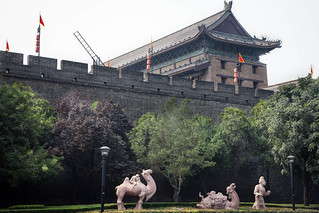 It is obvious to see that Xi'An was a gateway to the western world from China. There are definitely people with different facial structures, and the art is also a bit different from Eastern China. I also noticed many people using the park which goes around the outside of the wall, like these guys playing a game on the sidewalk.
It is obvious to see that Xi'An was a gateway to the western world from China. There are definitely people with different facial structures, and the art is also a bit different from Eastern China. I also noticed many people using the park which goes around the outside of the wall, like these guys playing a game on the sidewalk. 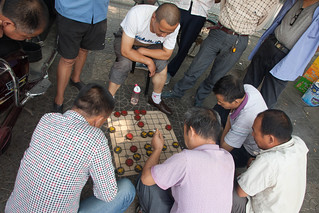
The first day, our guide MJ, who was absolutely wonderful by the way, took us to the Muslim quarter, and around a bit of the city. We saw the Great Mosque. It was really interesting because it obviously had some Chinese elements one would not normally expect to see in a mosque. For instance there were carvings of animals on some of the walls. I didn't get many good pictures in the Mosque.
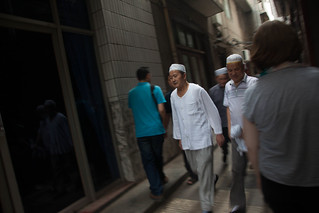 But we did get to see much of the daily life going on in the Muslim Quarter, which literally was 1/4 of the old city, right around the corner from our hotel.
But we did get to see much of the daily life going on in the Muslim Quarter, which literally was 1/4 of the old city, right around the corner from our hotel. 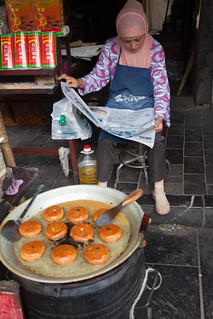
We had a delicious local dinner that evening-- dumplings. They served it at a restaurant in the hotel, where there was also a performance which hilighted the old court in the city, since it used to be one of the capitals of China.
Saturday we went to see the Big Wild Goose Pagoda, on the way to the terracotta warriors.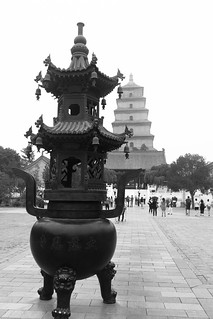
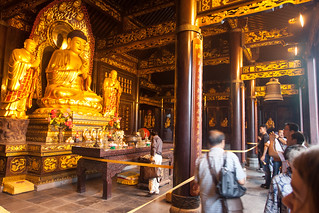
The story of the monk who went to India(basically fleeing) and how he spent time there becoming one of the highest deciples of Buddhism, and then his return to China is rather interesting. He wrote a diary of his trip, and it is used by historians to understand life in those times. He came back to China and once the pagoda was built, the Emperor made him abbot.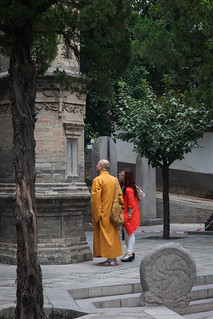 Many of the abbots' remains are buried here, some marked just by stones, others with slightly more elaborate markings. The grounds around the pagoda are pretty, and I ran across this gate/doorway to the office, which I thought very beautiful.
Many of the abbots' remains are buried here, some marked just by stones, others with slightly more elaborate markings. The grounds around the pagoda are pretty, and I ran across this gate/doorway to the office, which I thought very beautiful. 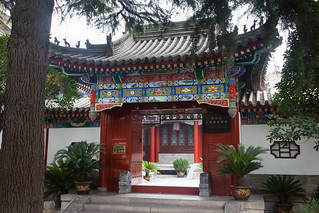 I wish the entrance to my office was so nice...
I wish the entrance to my office was so nice...
From there we proceeded to the Terracotta Warriors and Horses. The complex is large, and you have to ride up to the museum complex from the parking lot in small electric carts (or you can walk). We got up to the main complex and went in to the first of the "pits". The pits are exactly that, places where the archeologists have dug down to find the terracotta warriors and horses. The main pit is huge, the building covering it is on the scale of an airplane hangar.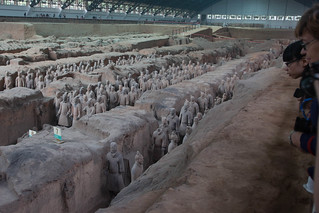 This first picture is a view of about half the buiding, looking down the length of it. There are thousands of these terracotta warriors, each of which has been painstakingly put back together after being dug up. They were broken either by a mob which entered the tomb during an uprising shortly after the Emperor died, or by the collapse of the tomb from fires set by the mob. Here you can see across the pit, at the front row.
This first picture is a view of about half the buiding, looking down the length of it. There are thousands of these terracotta warriors, each of which has been painstakingly put back together after being dug up. They were broken either by a mob which entered the tomb during an uprising shortly after the Emperor died, or by the collapse of the tomb from fires set by the mob. Here you can see across the pit, at the front row. 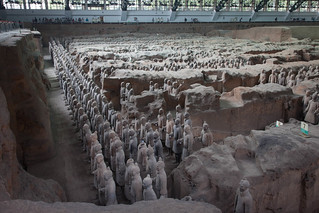 These guys were made by hand, Maybe some of the body parts were moulded but the heads and faces particularly were each differently shaped. Some of the faces are definitely mongol in nature, others more "classic chinese". MJ explained how you could tell the different types of warriors by their hair style and other attributes. The infantry had one "knot" on the right side, archers wore it on the left so as not to interfere with the bowstring. The higher ranks had two knots...
These guys were made by hand, Maybe some of the body parts were moulded but the heads and faces particularly were each differently shaped. Some of the faces are definitely mongol in nature, others more "classic chinese". MJ explained how you could tell the different types of warriors by their hair style and other attributes. The infantry had one "knot" on the right side, archers wore it on the left so as not to interfere with the bowstring. The higher ranks had two knots... 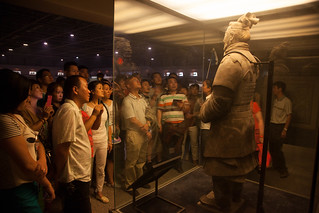 This general was obviously fairly well off as he had a bit of a paunch, not skinny like the infantrymen. Fortunately we weren't there during a big holiday time as the crowds were manageable. MJ said that Xi'An gets 10 million visitors a year, mostly Chinese.
This general was obviously fairly well off as he had a bit of a paunch, not skinny like the infantrymen. Fortunately we weren't there during a big holiday time as the crowds were manageable. MJ said that Xi'An gets 10 million visitors a year, mostly Chinese.
After viewing the first pit, we went to lunch. Outside the restaurant I caught this guy obviously waiting for his guests, riding a Jade Horse while texting on his phone.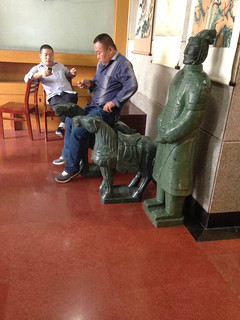
We saw two more pits after lunch, and then a short movie about the history of the place, and its importance as a historical site. We also bought a book which was signed by the farmer who found the first shards and brought them to the attention of the government. He's a bit of a celebrity in Xi'An because he helped establish it as a major tourist destination.
Sunday, our last day, we started the day with a walk (and bicycle ride) on the city walls. They are fairly well maintained and have been upgraded a couple of times. They started out as rammed earth, then brickwork was added later, and finally there were rain gutters an other adornments added.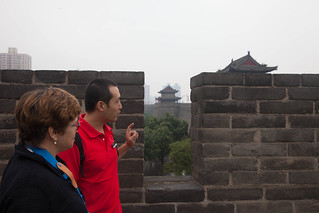 Here you see MJ explaining to Cindy why the abutments (buildings on the wall) are spaced at even distance of 60 Meters all around the wall. This has to do with how far arrows will fly for the defense of the wall.
Here you see MJ explaining to Cindy why the abutments (buildings on the wall) are spaced at even distance of 60 Meters all around the wall. This has to do with how far arrows will fly for the defense of the wall. 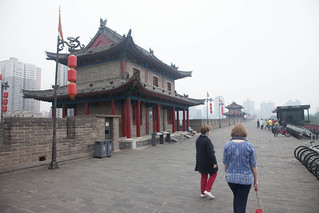 It was a grey day, and was raining when we first climbed the wall. But by the end it was dry enough for us to rent bikes and ride a ways around the wall. Rather bumpy, but fun. After going on the wall, we were taken to a local gallery where we had the opportunity to learn a bit about Chinese calligraphy, practice a bit ourselves, and see some of the local art. We saw both folk art styles and more modern styles, though the folk art was more interesting to us.
It was a grey day, and was raining when we first climbed the wall. But by the end it was dry enough for us to rent bikes and ride a ways around the wall. Rather bumpy, but fun. After going on the wall, we were taken to a local gallery where we had the opportunity to learn a bit about Chinese calligraphy, practice a bit ourselves, and see some of the local art. We saw both folk art styles and more modern styles, though the folk art was more interesting to us.
Finally then after lunch at Grandma's Impressions. We went on to one more Emperor's tomb (Hanyang tombs). He came after the one who had the terra cotta warriors and horses we saw first, and since the economy wasn't doing so well, and he realized that maybe there would be another revolt if he spent so much on his afterlife preparations, all of his terracotta warriors, horses, pigs, fowl, courtiers, etc were scaled down. The site was found in the 80's when the expressway was being built. The government knew there were tombs in the area, but didn't know that they extended so far beyond the actual burial mounds which are still visible from a fair distance away. The museum is much more modern, accessible, and the viewing of the artifacts still in the ground is much closer, but it would not be able to handle quite the crowds that the first site can. Here are a few photos.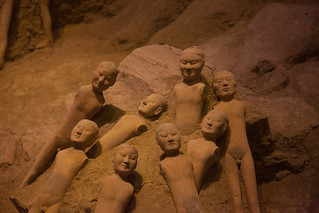
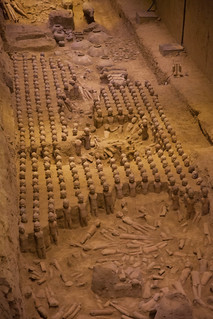
Then we had to go to the airport and fly home. Again MJ was great. We booked him through China Oddysey Tours.
And as always there's more on my Flickr.
Before Cindy and Maya arrived I took a short walk from our hotel to the West Gate.
 It is obvious to see that Xi'An was a gateway to the western world from China. There are definitely people with different facial structures, and the art is also a bit different from Eastern China. I also noticed many people using the park which goes around the outside of the wall, like these guys playing a game on the sidewalk.
It is obvious to see that Xi'An was a gateway to the western world from China. There are definitely people with different facial structures, and the art is also a bit different from Eastern China. I also noticed many people using the park which goes around the outside of the wall, like these guys playing a game on the sidewalk. 
The first day, our guide MJ, who was absolutely wonderful by the way, took us to the Muslim quarter, and around a bit of the city. We saw the Great Mosque. It was really interesting because it obviously had some Chinese elements one would not normally expect to see in a mosque. For instance there were carvings of animals on some of the walls. I didn't get many good pictures in the Mosque.
 But we did get to see much of the daily life going on in the Muslim Quarter, which literally was 1/4 of the old city, right around the corner from our hotel.
But we did get to see much of the daily life going on in the Muslim Quarter, which literally was 1/4 of the old city, right around the corner from our hotel. 
We had a delicious local dinner that evening-- dumplings. They served it at a restaurant in the hotel, where there was also a performance which hilighted the old court in the city, since it used to be one of the capitals of China.
Saturday we went to see the Big Wild Goose Pagoda, on the way to the terracotta warriors.


The story of the monk who went to India(basically fleeing) and how he spent time there becoming one of the highest deciples of Buddhism, and then his return to China is rather interesting. He wrote a diary of his trip, and it is used by historians to understand life in those times. He came back to China and once the pagoda was built, the Emperor made him abbot.
 Many of the abbots' remains are buried here, some marked just by stones, others with slightly more elaborate markings. The grounds around the pagoda are pretty, and I ran across this gate/doorway to the office, which I thought very beautiful.
Many of the abbots' remains are buried here, some marked just by stones, others with slightly more elaborate markings. The grounds around the pagoda are pretty, and I ran across this gate/doorway to the office, which I thought very beautiful.  I wish the entrance to my office was so nice...
I wish the entrance to my office was so nice...From there we proceeded to the Terracotta Warriors and Horses. The complex is large, and you have to ride up to the museum complex from the parking lot in small electric carts (or you can walk). We got up to the main complex and went in to the first of the "pits". The pits are exactly that, places where the archeologists have dug down to find the terracotta warriors and horses. The main pit is huge, the building covering it is on the scale of an airplane hangar.
 This first picture is a view of about half the buiding, looking down the length of it. There are thousands of these terracotta warriors, each of which has been painstakingly put back together after being dug up. They were broken either by a mob which entered the tomb during an uprising shortly after the Emperor died, or by the collapse of the tomb from fires set by the mob. Here you can see across the pit, at the front row.
This first picture is a view of about half the buiding, looking down the length of it. There are thousands of these terracotta warriors, each of which has been painstakingly put back together after being dug up. They were broken either by a mob which entered the tomb during an uprising shortly after the Emperor died, or by the collapse of the tomb from fires set by the mob. Here you can see across the pit, at the front row.  These guys were made by hand, Maybe some of the body parts were moulded but the heads and faces particularly were each differently shaped. Some of the faces are definitely mongol in nature, others more "classic chinese". MJ explained how you could tell the different types of warriors by their hair style and other attributes. The infantry had one "knot" on the right side, archers wore it on the left so as not to interfere with the bowstring. The higher ranks had two knots...
These guys were made by hand, Maybe some of the body parts were moulded but the heads and faces particularly were each differently shaped. Some of the faces are definitely mongol in nature, others more "classic chinese". MJ explained how you could tell the different types of warriors by their hair style and other attributes. The infantry had one "knot" on the right side, archers wore it on the left so as not to interfere with the bowstring. The higher ranks had two knots...  This general was obviously fairly well off as he had a bit of a paunch, not skinny like the infantrymen. Fortunately we weren't there during a big holiday time as the crowds were manageable. MJ said that Xi'An gets 10 million visitors a year, mostly Chinese.
This general was obviously fairly well off as he had a bit of a paunch, not skinny like the infantrymen. Fortunately we weren't there during a big holiday time as the crowds were manageable. MJ said that Xi'An gets 10 million visitors a year, mostly Chinese.After viewing the first pit, we went to lunch. Outside the restaurant I caught this guy obviously waiting for his guests, riding a Jade Horse while texting on his phone.

We saw two more pits after lunch, and then a short movie about the history of the place, and its importance as a historical site. We also bought a book which was signed by the farmer who found the first shards and brought them to the attention of the government. He's a bit of a celebrity in Xi'An because he helped establish it as a major tourist destination.
Sunday, our last day, we started the day with a walk (and bicycle ride) on the city walls. They are fairly well maintained and have been upgraded a couple of times. They started out as rammed earth, then brickwork was added later, and finally there were rain gutters an other adornments added.
 Here you see MJ explaining to Cindy why the abutments (buildings on the wall) are spaced at even distance of 60 Meters all around the wall. This has to do with how far arrows will fly for the defense of the wall.
Here you see MJ explaining to Cindy why the abutments (buildings on the wall) are spaced at even distance of 60 Meters all around the wall. This has to do with how far arrows will fly for the defense of the wall.  It was a grey day, and was raining when we first climbed the wall. But by the end it was dry enough for us to rent bikes and ride a ways around the wall. Rather bumpy, but fun. After going on the wall, we were taken to a local gallery where we had the opportunity to learn a bit about Chinese calligraphy, practice a bit ourselves, and see some of the local art. We saw both folk art styles and more modern styles, though the folk art was more interesting to us.
It was a grey day, and was raining when we first climbed the wall. But by the end it was dry enough for us to rent bikes and ride a ways around the wall. Rather bumpy, but fun. After going on the wall, we were taken to a local gallery where we had the opportunity to learn a bit about Chinese calligraphy, practice a bit ourselves, and see some of the local art. We saw both folk art styles and more modern styles, though the folk art was more interesting to us.Finally then after lunch at Grandma's Impressions. We went on to one more Emperor's tomb (Hanyang tombs). He came after the one who had the terra cotta warriors and horses we saw first, and since the economy wasn't doing so well, and he realized that maybe there would be another revolt if he spent so much on his afterlife preparations, all of his terracotta warriors, horses, pigs, fowl, courtiers, etc were scaled down. The site was found in the 80's when the expressway was being built. The government knew there were tombs in the area, but didn't know that they extended so far beyond the actual burial mounds which are still visible from a fair distance away. The museum is much more modern, accessible, and the viewing of the artifacts still in the ground is much closer, but it would not be able to handle quite the crowds that the first site can. Here are a few photos.


Then we had to go to the airport and fly home. Again MJ was great. We booked him through China Oddysey Tours.
And as always there's more on my Flickr.
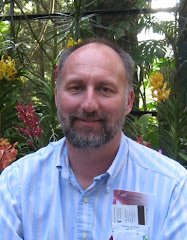
No comments:
Post a Comment